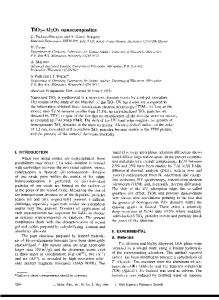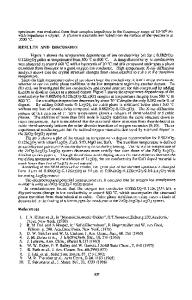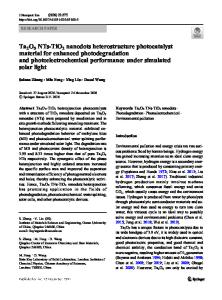Dielectric ceramics in the BaO-Sm 2 O 3 -TiO 2 -Ta 2 O 5 quaternary system
- PDF / 453,268 Bytes
- 5 Pages / 612 x 792 pts (letter) Page_size
- 47 Downloads / 441 Views
MATERIALS RESEARCH
Welcome
Comments
Help
Dielectric ceramics in the BaO–Sm2O3–TiO2–Ta2O5 quaternary system X.M. Chen, Z.Y. Xu, and J. Li Laboratory of Materials for Electronics and Communication, Department of Materials Science & Engineering, Zhejiang University, Hangzhou 310027, People’s Republic of China (Received 15 March 1999; accepted 19 October 1999)
Dielectric ceramics in the BaO–Sm2O3–TiO2–Ta2O5 quaternary system were prepared and characterized for five typical compositions: BaSm5Ti7Ta3O30, Ba2Sm4Ti6Ta4O30, Ba3Sm3Ti5Ta5O30, Ba4Sm2Ti4Ta6O30, and Ba5SmTi3Ta7O30. The latter three compositions tended to form the tungsten–bronze phase, and the ceramics based on these compositions had a high dielectric constant (134–175) and a low dielectric loss (on the order of 10−3) but a larger temperature coefficient of the dielectric constant. Meanwhile, the former two compositions generally had a more complex phase constitution, containing the tungsten–bronze phase combined with some unknown phase, and a relatively small temperature coefficient of the dielectric constant in the temperature range of 20 to 85 °C could be achieved in these two compositions.
I. INTRODUCTION
Recent development of microelectronic technologies and microwave communication technologies has been strongly driving the investigation of new dielectric materials with temperature-stable high ⑀ and low dielectric loss.1–7 So far, the most important high-⑀ dielectric ceramics, which are used both as temperature-compensated capacitors and microwave resonators, have been investigated and developed in the BaO–Ln2O3–TiO2 system (Ln ⳱ Nd, Sm). A dielectric constant of 80–94, a Qf [the product of quality factor (Q) and frequency (f)] value greater than 5,000 GHz, and a f value between −10 and 15 ppm/°C can be achieved for the modified ceramics in this system.3–7 For searching new materials with dielectric constants greater than 100, some work has been carried out in lead-containing perovskite systems,8,9 and the authors have proposed an alternative new material system of BaO–Nd2O3–TiO2–Ta2O5, where the ceramics with A6B10O30 tungsten–bronze structures have a dielectric constant of 70–160 and a very low dielectric loss even less than 0.0001 at 1 MHz.10,11 In the present work, dielectric ceramics in the BaO– Sm2O3–TiO2–Ta2O5 quaternary system are prepared and characterized, for five typical compositions BaSm5Ti7Ta 3 O 3 0 , Ba 2 Sm 4 Ti 6 Ta 4 O 3 0 , Ba 3 Sm 3 Ti 5 Ta 5 O 3 0 , Ba4Sm2Ti4Ta6O30, and Ba5SmTi3Ta7O30, and the interesting variation of dielectric properties with sintering temperature is discussed. II. EXPERIMENTS
High-purity powders of BaCO3 (>99.95%), Sm2O3 (>99.5%), TiO2 (>99.7%), and Ta2O5 (>99.99%) were adopted as the starting materials, and the objective ceJ. Mater. Res., Vol. 15, No. 1, Jan 2000
http://journals.cambridge.org
Downloaded: 23 Feb 2015
ramic powders with the compositions BaSm5Ti7Ta3O30, Ba 2 Sm 4 Ti 6 Ta 4 O 30 , Ba 3 Sm 3 Ti 5 Ta 5 O 30 , Ba 4 Sm 2 Ti 4 Ta6O30, and Ba5SmTi3Ta7O30 were synthesized by calcination of the mix
Data Loading...











